Hazard Assessments of Riverbank Flooding and Backward Flows in Dike-Through Drainage Ditches during Moderate Frequent Flooding Events in the Ningxia Reach of the Upper Yellow River (NRYR)
Abstract
1. Introduction
2. Research Area
3. Data and Methods
3.1. Data
3.2. Methods
3.2.1. Basic Multi-Source Data Analysis and Processing
3.2.2. Simulation Model of the Flood Evolution in the NRYR
3.2.3. Flood Hazard Data Information Vectorization and Damage Impact Assessment Method
3.2.4. Hazard Map for the Moderate Frequent Flood Damages in the NRYR
4. Results
4.1. Calibration and Validation of the Hazard Assessment Model for the Moderate Frequent Flooding Events
4.2. Evolution Process of the Moderate Frequent Flooding Events with Different Discharge Values
4.3. Riverbank Inundation Resulting from the Moderate Frequent Flooding and Backward Flows in the Dike-Through Drainage Ditches
4.3.1. Riverbank Inundation Hazard
4.3.2. Backward Flow Hazards of the Dike-Through Drainage Ditches
4.4. Map of the Flood Hazards Related to the Moderate Frequent Flood Damages in the NRYR
5. Discussion
5.1. Applications of This Study’s Integration Method Using GIS and a River Hydrodynamic Model
5.2. Hazard Assessments for Riverbank Inundation Caused by the Moderate Frequent Flooding Events and Backward Flows of the Dike-Through Drainage Ditches
5.3. Potential Impacts on the Study Area of Moderate Frequent Flooding Damages
5.3.1. Impacts on the Coastal Water Diversion Projects
5.3.2. Impacts on the River Regulation Structures
5.3.3. Impacts on the Ecological Environments of the Rivers
5.4. Flood Control and Damage Reduction Measures against Moderate Frequent Flooding in the NRYR
6. Conclusions
Author Contributions
Funding
Acknowledgments
Conflicts of Interest
References
- Zuo, H.; Yan, Y.; Zhang, S.; Chen, Y.; Chen, M.; Sun, B.; Zhang, Y. Record of major flood and waterlogging disasters prevention since 1949 in China. China Flood Drought Manag. 2009, 29, 20–38. (In Chinese) [Google Scholar]
- Zhang, X.; Xia, J.; Li, N. Impacts of mesh scale and village region roughness on predictions of flood inundation over complex floodplains. J. Hydroelectr. Eng. 2016, 35, 48–57. (In Chinese) [Google Scholar]
- Tian, F. Numerical Simulation of 2D Coupling Hydrodynamic Model of River Channel-Flood Plain Two-Dimensional and Its Application in Flood Risk Analysis. Master’s Thesis, Tianjin University, Tianjing, China, 2014. (In Chinese). [Google Scholar]
- Panda, R.K.; Pramanik, N.; Bala, B. Simulation of river stage using artificial neural network and MIKE 11 hydrodynamic model. Comput. Geosci. 2010, 36, 735–745. [Google Scholar] [CrossRef]
- Mohammadi, S.A.; Nazariha, M.; Mehrdadi, N. Flood damage estimate (quantity), using HEC-FDA Model. Case study: The Neka River. Procedia Eng. 2014, 70, 1173–1182. [Google Scholar] [CrossRef]
- Merkuryeva, G.; Merkuryev, Y.; Sokolov, B.V.; Potryasaev, S.; Zelentsov, V.A.; Lektauers, A. Advanced river flood monitoring, modelling and forecasting. J. Comput. Sci. 2015, 10, 77–85. [Google Scholar] [CrossRef]
- Pearson, A.J.; Pizzuto, J. Bedload transport over run-of-river dams, Delaware, USA. Geomorphology 2015, 248, 382–395. [Google Scholar] [CrossRef]
- Shelley, J.; Gibson, S.; Williams, A. Unsteady flow and sediment modeling in a large reservoir using HEC-RAS 5.0. In Proceedings of the 2005 Federal Interagency Sediment Conference, Reno, NV, USA, 19–23 April 2015. [Google Scholar]
- Dai, B.T.; Mussetter, R.A.; Boberg, S.A. FLO-2D modeling to support the Rio Grande Bosque restoration feasibility study, Albuquerque reach of the middle Rio Grande, New Mexico. In Proceedings of the World Environmental and Water Resources Congress, Albuquerque, NM, USA, 20–24 May 2012; pp. 2593–2602. [Google Scholar]
- Adegbe, M.; Alkem, D.; Jetten, V.G.; Agbor, A.T.; Abdullahi, I.N.; Shehu, O.U.; Unubi, A.S. Post seismic debris flow modelling using Flo-2D; case study of Yingxiu, Sichuan Province, China. J. Geogr. Geol. 2013, 5, 101–115. [Google Scholar]
- Yu, C.; Duan, J. Two-dimensional hydrodynamic model for surface-flow routing. J. Hydraul. Eng. 2014, 140, 04014045. [Google Scholar] [CrossRef]
- Lanni, C.; Mazzorana, B.; Macconi, P.; Bertagnolli, R. Suitability of mono-and two-phase modeling of debris flows for the assessment of granular debris flow hazards: Insights from a case study. In Engineering Geology for Society and Territory; Springer International Publishing: Cham, Switzerland, 2015; Volume 2, pp. 537–543. [Google Scholar]
- Wang, X.; Wang, L.; Tian, F.; Yuan, X. Two-dimensional flood calculation model of overflow, levee breach and flood control protected area based on spatiotemporal dynamic coupling. J. Nat. Disasters 2015, 24, 57–63. (In Chinese) [Google Scholar]
- Yuan, X.; Tian, F.; Feng, G.; Wang, L. Two-dimensional hydrodynamic model and its application of levee-breach flood. South North Water Transf. Water Sci. Technol. 2015, 13, 225–230. (In Chinese) [Google Scholar]
- Yuan, X.; Tian, F.; Wang, L. Comprehensive two-dimensional associate hydrodynamic models for overflow and levee-breach flood and its application. Adv. Water Sci. 2015, 26, 83–90. (In Chinese) [Google Scholar]
- Dutta, D.; Alam, J.; Umeda, K.; Hayashi, M.; Hironaka, S. A two-dimensional hydrodynamic model for flood inundation simulation: A case study in the lower Mekong river basin. Hydrol. Process. 2007, 21, 1223–1237. [Google Scholar] [CrossRef]
- Lin, B.; Falconer, R.A.; Liang, D. Linking one-and two-dimensional models for free surface flows. Water Manag. 2007, 160, 145–151. [Google Scholar]
- Li, D.; Lin, Y.; Zhou, Z. Research on 1D and 2D numerical simulation of flood routing and its application of combined-regulation in detention basin. Eng. Sci. 2010, 12, 82–89. (In Chinese) [Google Scholar]
- Zhang, D.; Li, D.; Chen, Z.; Wang, X. Coupled one-and two-dimensional hydrodynamic models for levee-breach flood and its application. J. Hydroelectr. Eng. 2010, 29, 149–154. (In Chinese) [Google Scholar]
- Benjankar, R.; Tonina, D.; Mckean, J. One-dimensional and two-dimensional hydrodynamic modeling derived flow properties: Impacts on aquatic habitat quality predictions. Earth Surf. Process. Landf. 2014, 40, 340–356. [Google Scholar] [CrossRef]
- Yuan, X.; Pang, J.; Tian, F.; Li, C. Application of multi-breach river network coupling model in flood analysis of flood control protection zone. J. Water Resour. Water Eng. 2016, 27, 128–135. (In Chinese) [Google Scholar]
- Yuan, X.; Xue, W.; Feng, G.; Li, C. A coupled one-and two-dimensional hydrodynamic model for analysis of levee-breach flood and its application. Adv. Sci. Technol. Water Resour. 2016, 36, 53–58. (In Chinese) [Google Scholar]
- Stoesser, T.; Wilson, C.; Bates, P.; Dittrich, A. Application of a 3D numerical model to a river with vegetated floodplains. J. Hydroinform. 2003, 5, 99–112. [Google Scholar] [CrossRef]
- Andersson, L.; Blue, P.; Nicolas, J.P. Calibration of numerical models for small debris flows in Yosemite Valley, California, USA. Nat. Hazards Earth Syst. Sci. 2005, 5, 993–1001. [Google Scholar]
- Yuan, P.; Zhang, J.; Duan, H.; Liu, P. Study on the calculation of the flood around the village platform at beach in the lower reaches of the Yellow River. Yellow River 2009, 31, 104–109. (In Chinese) [Google Scholar]
- Toombes, L.; Chanson, H. Numerical limitations of hydraulic models. In Proceedings of the 34th IAHR World Congress, 33rd Hydrology and Water Resources Symposium and 10th Conference on Hydraulics in Water Engineering, Brisbane, Australia, 26 June–1 July 2011; Engineers Australia: Barton, Australia, 2011; pp. 2322–2329. [Google Scholar]
- Li, C. Numerical Investigation of a hybrid wave absorption method in 3D numerical wave tank. Comput. Model. Eng. Sci. 2015, 107, 125–153. [Google Scholar]
- Li, C.; Campbell, B.K.; Liu, Y.; Yue, D.K.P. A fast multi-layer boundary element method for direct numerical simulation of sound propagation in shallow water environments. J. Comput. Phys. 2019, 392, 694–712. [Google Scholar] [CrossRef]
- Anees, M.T.; Abdullah, K.; Nawawi, M.N.M.; Rahman, N.N.N.A.; Piah, A.R.M.; Zakaria, N.A.; Syakir, M.I.; Omar, A.K.M. Numerical modeling techniques for flood analysis. J. Afr. Earth Sci. 2016, 124, 478–486. [Google Scholar] [CrossRef]
- Wan, H.; Zhou, C.; Wan, Q.; Wang, C. The construction of flood routing model supported by GIS Technology. Geogr. Res. 2001, 20, 407–415. (In Chinese) [Google Scholar]
- Ding, Z.; Li, J.; Li, L. Method for flood submergence analysis based on GIS grid model. J. Hydraul. Eng. 2004, 35, 56–60. [Google Scholar]
- Liu, Y.B.; Smedt, F.D. Flood modeling for complex terrain using GIS and remote sensed information. Water Resour. Manag. 2005, 19, 605–624. [Google Scholar] [CrossRef]
- Zhang, Y.; Dong, J.; Han, M. Research of flood routing simulation system based on GIS. Chin. J. Sci. Instrum. 2006, 27, 936–937. (In Chinese) [Google Scholar]
- Merwade, V.; Cook, A.; Coonrod, J. GIS techniques for creating river terrain models for hydrodynamic modeling and flood inundation mapping. Environ. Model. Softw. 2008, 23, 1300–1311. [Google Scholar] [CrossRef]
- Chen, K. Research and implementation of GIS-based flood assessment system. J. Catastrophol. 2009, 24, 35–39. (In Chinese) [Google Scholar]
- Zhang, D.H.; Liu, R.; Zhang, Y.X.; Xie, J.H. The design and implement of a new algorithm to calculate source flood submerge area based on Dem. J. East China Inst. Technol. 2009, 32, 181–184. (In Chinese) [Google Scholar]
- Chen, Y.; Wang, B.; Pollino, C.A.; Cuddy, S.M.; Merrin, L.E.; Huang, C. Estimate of flood inundation and retention on wetlands using remote sensing and GIS. Ecohydrology 2014, 7, 1412–1420. [Google Scholar] [CrossRef]
- Teng, J.; Vaze, J.; Dutta, D.; Marvanek, S. Rapid inundation modelling in large floodplains using LiDAR DEM. Water Resour. Manag. 2015, 29, 2619–2636. [Google Scholar] [CrossRef]
- Li, N.; Cheng, X.; Yuan, X.; Hu, C. Development of Shanghai flood risk mapping and information query system. Water Resour. Manag. 2002, 2, 48–49. (In Chinese) [Google Scholar]
- Sinnakaudan, S.K.; Ghani, A.A.; Ahmad, M.S.S.; Zakaria, N.A. Flood risk mapping for Pari River incorporating sediment transport. Environ. Model. Softw. 2003, 18, 119–130. [Google Scholar] [CrossRef]
- Zhu, Q. Research of 2D Water and Sediment Numerical Modeling Based on GIS and Its Application in the Lower Yellow River. Ph.D. Thesis, Hohai University, Nanjing, China, 2005. (In Chinese). [Google Scholar]
- Wei, Y.; Yao, B.; Xin, G.; Yang, H. Application of ArcGIS in flood risk map system of Yellow River beach area. Yellow River 2009, 31, 99. (In Chinese) [Google Scholar]
- Fu, C.; Yuan, X.; Yang, M. A real-time dynamic coupling model for flood routing and its application to flood risk charting. Hydro-Sci. Eng. 2013, 5, 32–38. (In Chinese) [Google Scholar]
- Patra, J.P.; Kumar, R.; Mani, P. Combined fluvial and pluvial flood inundation modelling for a project site. Procedia Technol. 2016, 24, 93–100. [Google Scholar] [CrossRef]
- Yuan, X.; Tian, F. Research on the Flood Analysis and Risk Mapping of Flood-Protected Area in the Ningxia Reach of Yellow River; China Water & Power Press: Beijing, China, 2016. (In Chinese) [Google Scholar]
- Mentzafou, A.; Markogianni, V.; Dimitriou, E. The use of geospatial technologies in flood hazard mapping and assessment: Case study from River Evros. Pure Appl. Geophys. 2017, 174, 679–700. [Google Scholar] [CrossRef]
- Vu, T.T.; Ranzi, R. Flood risk assessment and coping capacity of floods in central Vietnam. J. Hydro-Environ. Res. 2017, 14, 44–60. [Google Scholar] [CrossRef]
- Mohammed, M.P. Flood hazard zoning of Tarlac City: Towards the development of flood overlay zones and provision. Procedia Eng. 2018, 212, 69–76. [Google Scholar] [CrossRef]
- Li, G. Flood loss assessment technique and its application based on GIS. Geogr. Geo-Inf. Sci. 2003, 19, 97–100. (In Chinese) [Google Scholar]
- Qin, N.; Jiang, T. GIS based risk zoning and assessment of flood disaster in the middle and lower reaches of the Yangtze River Basin. J. Nat. Disasters 2005, 14, 1–7. (In Chinese) [Google Scholar]
- Yuan, X. The application of modern information technology in flood control and disaster reduction. China Flood Drought Manag. 2010, 20, 24–27. (In Chinese) [Google Scholar]
- Ntajal, J.; Lamptey, B.L.; Mahamadou, I.B.; Nyarko, B.K. Flood disaster risk mapping in the Lower Mono River Basin in Togo, West Africa. Int. J. Disaster Risk Reduct. 2017, 23, 93–103. [Google Scholar] [CrossRef]
- Yousefi, S.; Mirzaee, S.; Keesstra, S.; Surian, N.; Pourghasemi, H.R.; Zakizadeh, H.R.; Tabibian, S. Effects of an extreme flood on river morphology (case study: Karoon River, Iran). Geomorphology 2018, 304, 30–39. [Google Scholar] [CrossRef]
- Dai, Y.; Kanae, S.; Kim, H.; Oki, T. A physically based description of floodplain inundation dynamics in a global river routing model. Water Resour. Res. 2011, 54, W04501. [Google Scholar]
- Paz, A.R.D.; Collischonn, W.; Tucci, C.E.M.; Padovani, C.R. Large-scale modelling of channel flow and floodplain inundation dynamics and its application to the Pantanal (Brazil). Hydrol. Process. 2011, 25, 1498–1516. [Google Scholar] [CrossRef]
- Neal, J.; Schumann, G.J.-P.; Bates, P.D. A simple model for simulating river hydraulics and floodplain inundation over large and data sparse areas. Water Resour. Res. 2012, 48, W11506. [Google Scholar] [CrossRef]
- Pappenberger, F.; Dutra, E.; Wetterhall, F.; Cloke, H.L. Deriving global flood hazard maps of fluvial floods through a physical model cascade. Hydrol. Earth Syst. Sci. Discuss. 2012, 9, 6615–6647. [Google Scholar] [CrossRef]
- Westerhoff, R.S.; Kleuskens, M.P.H.; Winsemius, H.C.; Huizinga, H.J. Automated global water mapping based on wide-swath orbital synthetic aperture radar. Hydrol. Earth Syst. Sci. 2013, 17, 651–663. [Google Scholar] [CrossRef]
- Tian, J.; Tian, F.; Li, T.; Sun, Q.; Li, X. Mountain ditch dam-break flood risk analysis based on fusion technology of GIS and hydrodynamic model. Water Resour. Power 2018, 36, 64–67. (In Chinese) [Google Scholar]
- Wang, L. Flood Simulation and Optimization Study on Risk Aversion Transfers in Flood Control Protected Zone Based on GIS. Master’s Thesis, Tianjin University, Tianjing, China, 2015. (In Chinese). [Google Scholar]
- Zhang, N. The Flood Risk Analysis of the Dam Break and Overflow Floods in Ningxia Section under the Encounter of Floods in Mainstream and Its Tributaries. Master’s Thesis, Tianjin University, Tianjing, China, 2015. (In Chinese). [Google Scholar]
- Hu, C. Changes in runoff and sediment loads of the Yellow River and its management strategies. J. Hydroelectr. Eng. 2016, 35, 1–11. (In Chinese) [Google Scholar]
- Yuan, X.; Tian, F.; Wang, X.; Chen, M.T. Small-scale sediment scouring and siltation laws in the evolution trends of fluvial facies in the Ningxia Plain Reaches of the Yellow River (NPRYR). Quat. Int. 2018, 476, 14–25. [Google Scholar] [CrossRef]
- Fan, X.; Shi, C.; Zhou, Y.; Du, J. Characteristics of flood regime in Ningxia-Inner Mongolia Reaches of the Upper Yellow River. Resour. Sci. 2012, 34, 65–73. (In Chinese) [Google Scholar]
- Zhang, S.; Wang, J.; Pan, Y. Researches of the Yellow River farm land reserve resources in Henan Province based on remote sensing and GIS technology. Areal Res. Dev. 2008, 27, 120–123. (In Chinese) [Google Scholar]
- Bi, J.; Huang, H.; Liu, Y. Flood trace extraction and flood inundation estimation using remote sensing and GIS. Remote Sens. Inf. 2016, 31, 147–152. (In Chinese) [Google Scholar]
- Wang, X.; Ling, H.; Wang, Y.; Zhong, D.; Zhang, H. Analysis on the 2012 flood in Ningxia Section of the Yellow River. Yellow River 2014, 36, 31–33. (In Chinese) [Google Scholar]
- Yue, Z.; Ma, X. Flow profile of the Ningxia Reach in the Yellow River with 2012 flood. J. Sediment Res. 2016, 1, 47–51. (In Chinese) [Google Scholar]
- Ningxia Water Conservancy. Study on the Management System of the Real-Time Dynamic Flood Risk Mapping in the Ningxia Reach of the Upper Yellow River from Xiaheyan to Shizuishan; Ningxia Water Conservancy: Yinchuan, China, 2016. (In Chinese) [Google Scholar]
- Hou, Z.; Guo, Y.; Li, Y. Impact of overbank flood study on the bank deposit main channel erosion and the flooded risk in the Lower Reaches of the Yellow River. Yellow River 2016, 38, 45–47. (In Chinese) [Google Scholar]
- Zhang, M.; Huang, H.; Zhang, X. A study of the characteristics of sedimentation in the Lower Yellow River during overbank floods. Adv. Water Sci. 2016, 27, 165–175. (In Chinese) [Google Scholar]
- Zhang, B.; Wang, W. Analysis on the flood control and disaster reduction in the lower Yellow River beach area. China Water Resour. 2007, 17, 43–46. (In Chinese) [Google Scholar]
- Huo, F.; Lan, H. Study of mitigation measures and analysis of flood risk at floodplain in the Yellow River downstream. Water Conserv. Sci. Technol. Econ. 2009, 15, 135–137. (In Chinese) [Google Scholar]
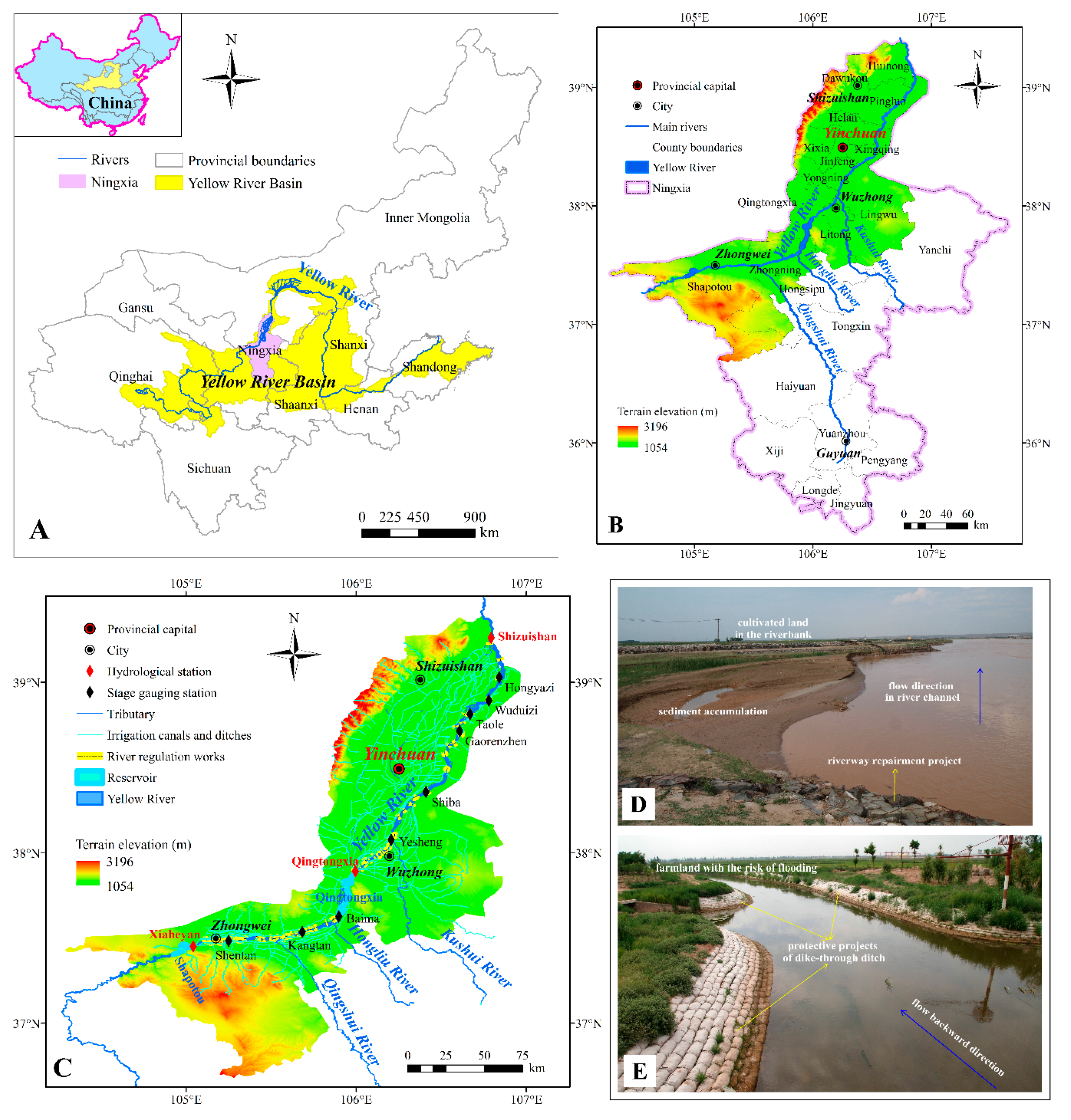
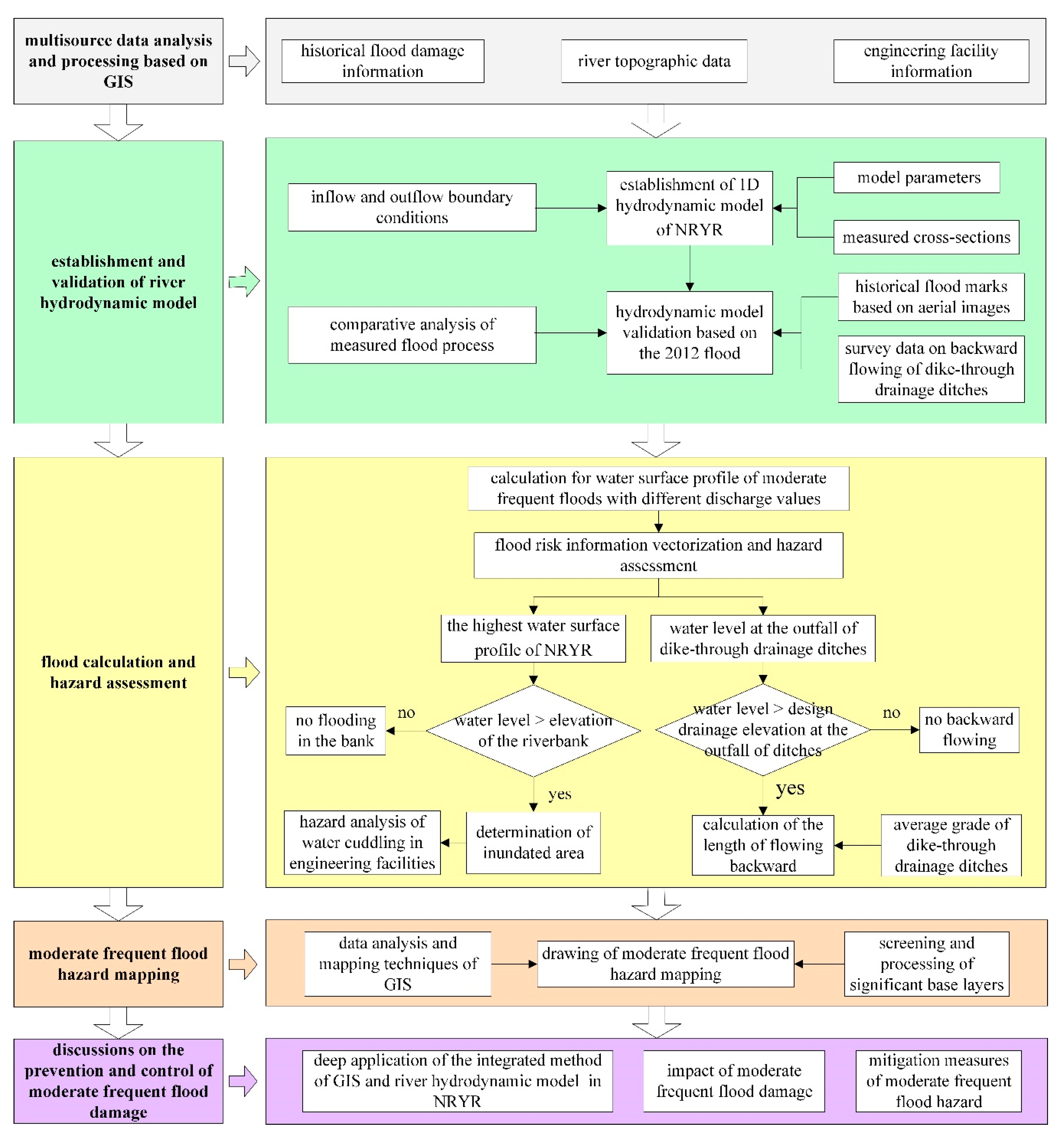


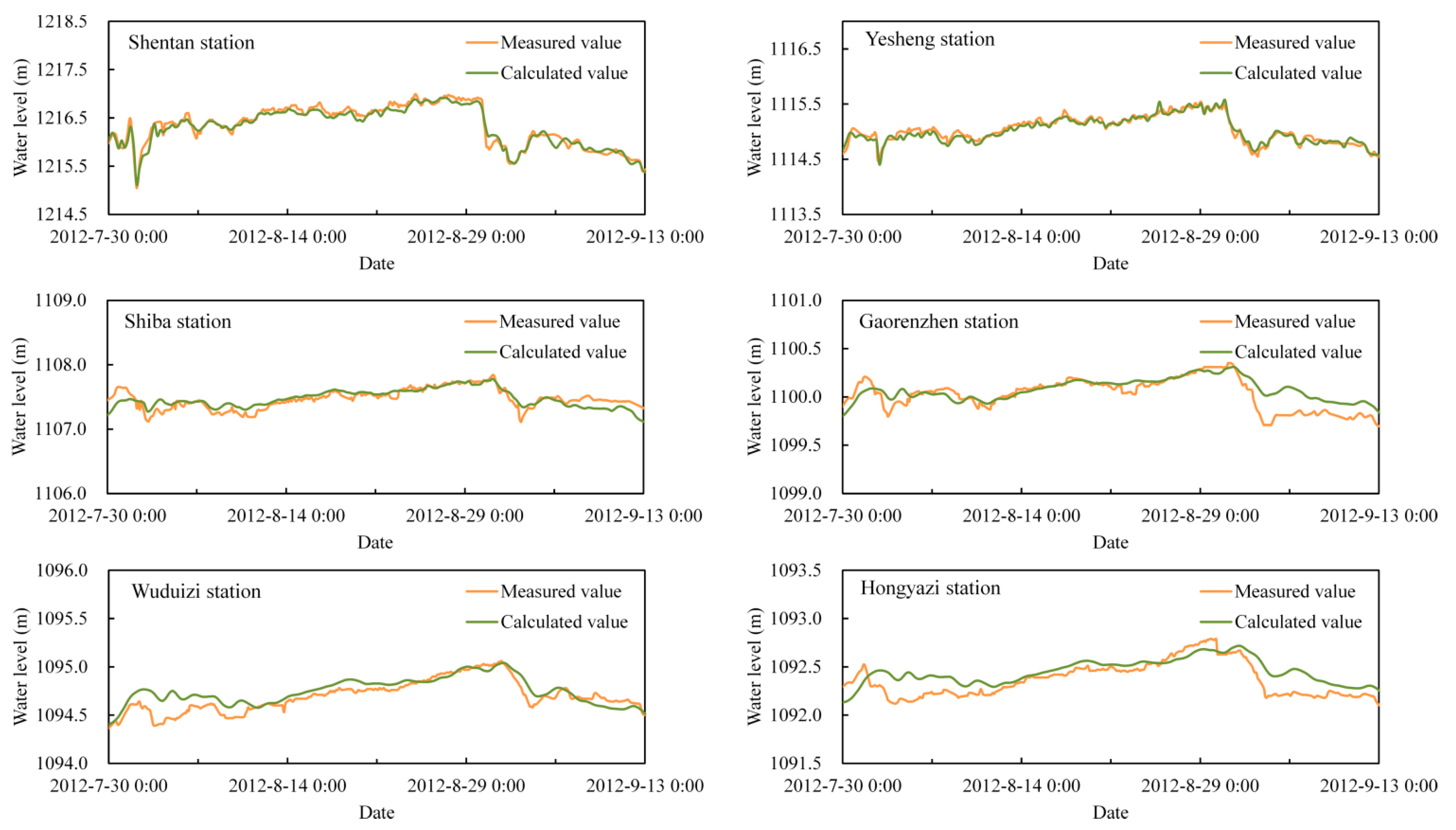

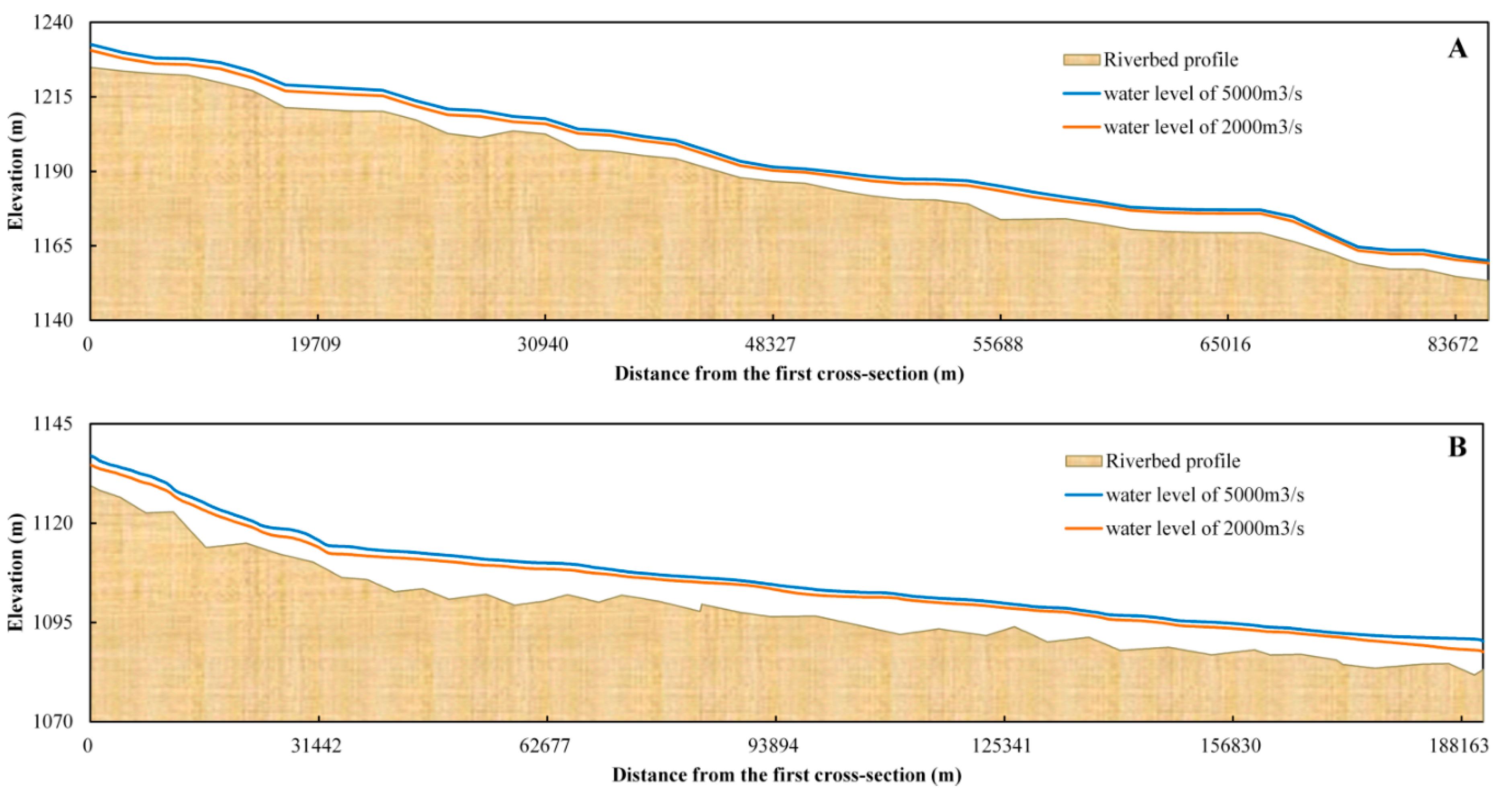
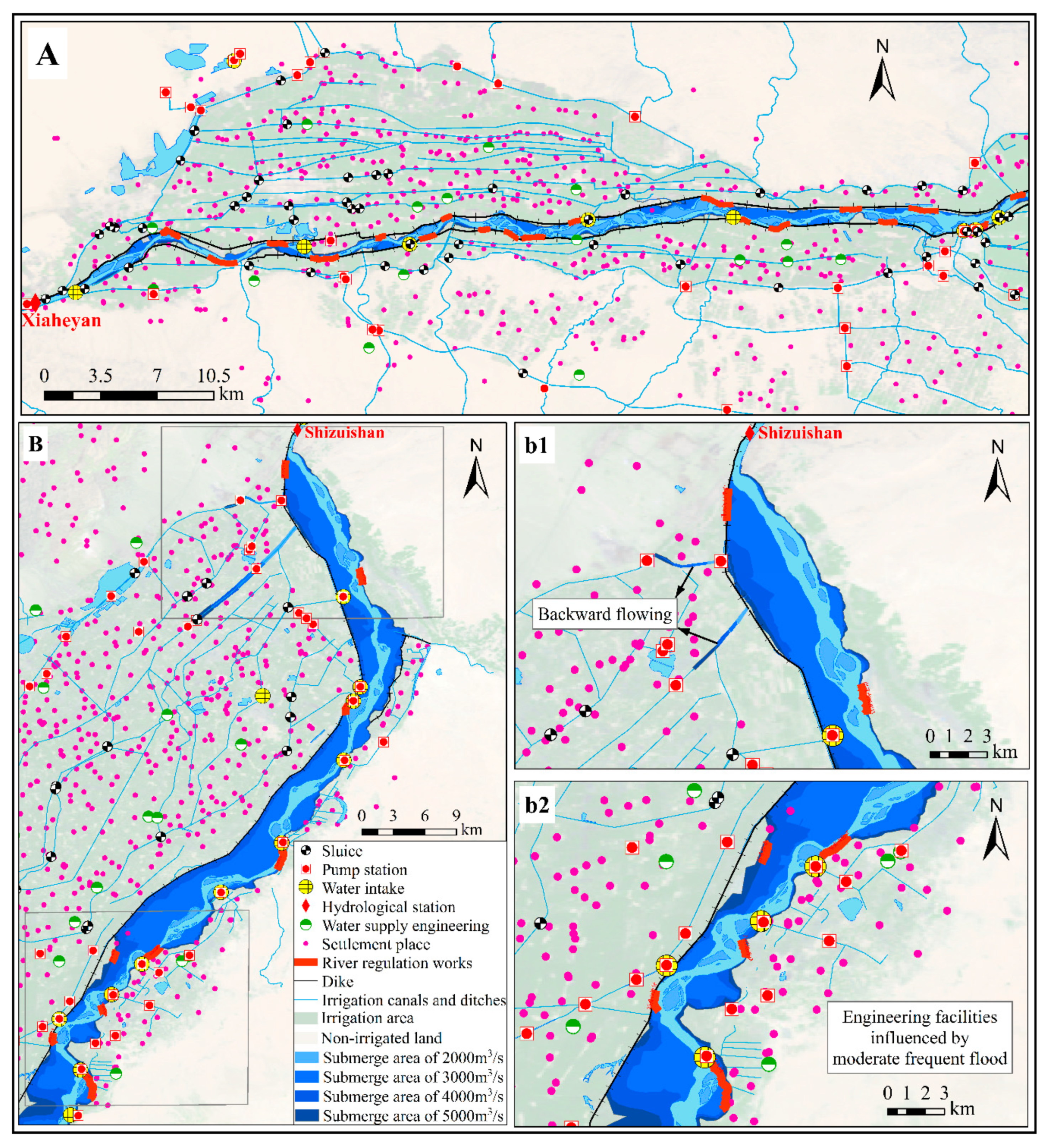
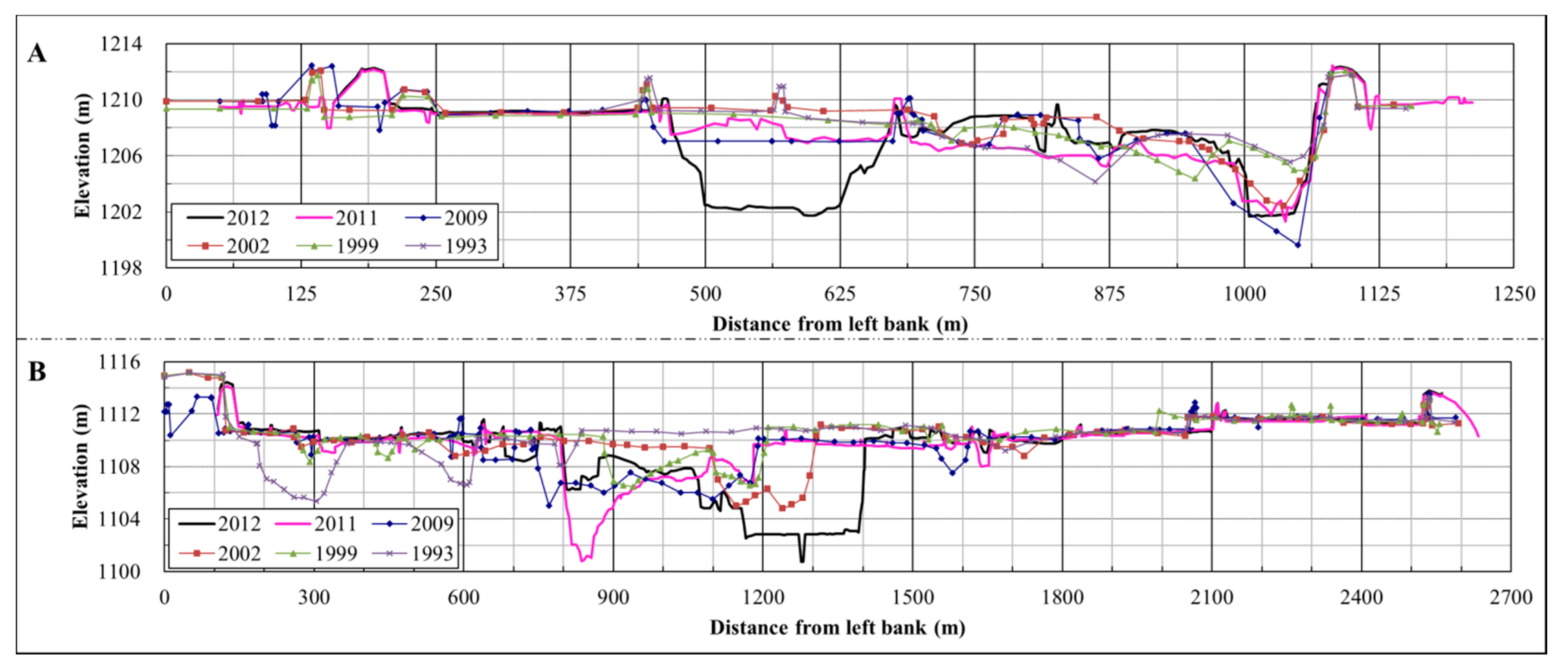


| Reach Name | Hazard Categories | Calculation Conditions of Moderate Frequent Flood | |||
|---|---|---|---|---|---|
| Q = 2000 m3/s | Q = 3000 m3/s | Q = 4000 m3/s | Q = 5000 m3/s | ||
| Weining Reach of the NRYR | Inundated area of bank (km2) | 7.28 | 10.77 | 13.99 | 18.95 |
| Main water-related engineering facilities | Yixintan, Xingongwan, Shuangqiao, Zhaotan | Nitan, Riverside Water Park in Zhongwei City, Yellow River Wetland Park, Yongfeng, Quanyanshan | Dahegong, Xindun, Yangjiahu, Liuwan, Fengzhuang, Kaigewan, Niding | Cuiyunsi, Huangyangwan, Shikongwan, Tiantan, Tongzhuang | |
| Qingshi Reach of the NRYR | Inundated area of bank (km2) | 64.75 | 107.24 | 218.68 | 264.56 |
| Main water-related engineering facilities | Xiyaozibai, Houwazitan, Sipaikou | Yellow River Ecological Park, Ecological Forest Demonstration Area, Huasan, Donghe, Tonggui, Lihe | Shizuizi Park, Xiabaqing, Beiya, Donglaidian, Toudaodun, Jingxing, Huangsha Ancient Ferry Scenic Area | Jinshui Amusement Park, Changhewan Leisure and Vacation Center, Guangming, Wuxiang, Guanqu | |
| Ditch Name | H0 (m) | i (‰) | Calculation Conditions of Moderate Frequent Flood | |||||||
|---|---|---|---|---|---|---|---|---|---|---|
| Q = 2000 m3/s | Q = 3000 m3/s | Q = 4000 m3/s | Q = 5000 m3/s | |||||||
| H (m) | L (m) | H (m) | L (m) | H (m) | L (m) | H (m) | L (m) | |||
| Yuejintuishui | 1201.25 | 0.82 | 1201.06 | 0.00 | 1201.72 | 573.17 | 1202.21 | 1170.73 | 1202.56 | 1597.56 |
| Qixing | 1189.62 | 1.37 | 1189.80 | 131.39 | 1190.42 | 583.94 | 1190.90 | 934.31 | 1191.23 | 1175.18 |
| Zhangyu | 1175.30 | 1.46 | 1176.04 | 506.85 | 1176.62 | 904.11 | 1177.07 | 1212.33 | 1177.44 | 1465.75 |
| Nanhezi | 1158.34 | 0.98 | 1160.05 | 1744.90 | 1160.68 | 2387.76 | 1161.20 | 2918.37 | 1161.52 | 3244.90 |
| Qinbaguan | 1126.69 | 0.53 | 1126.41 | 0.00 | 1126.99 | 566.04 | 1127.55 | 1622.64 | 1127.94 | 2358.49 |
| Qingshui | 1114.67 | 0.95 | 1115.81 | 1200.00 | 1116.73 | 2168.42 | 1117.23 | 2694.74 | 1117.54 | 3021.05 |
| Luojia | 1110.72 | 0.66 | 1111.42 | 1060.61 | 1112.62 | 2878.79 | 1113.10 | 3606.06 | 1113.42 | 4090.91 |
| No. 5 Paishui | 1087.56 | 0.52 | 1089.75 | 4211.54 | 1091.21 | 7019.23 | 1092.45 | 9403.85 | 1093.17 | 10,788.46 |
| No. 3 Paishui | 1085.68 | 0.94 | 1087.78 | 2234.04 | 1089.02 | 3553.19 | 1090.13 | 4734.04 | 1090.49 | 5117.02 |
© 2019 by the authors. Licensee MDPI, Basel, Switzerland. This article is an open access article distributed under the terms and conditions of the Creative Commons Attribution (CC BY) license (http://creativecommons.org/licenses/by/4.0/).
Share and Cite
Tian, F.; Ma, B.; Yuan, X.; Wang, X.; Yue, Z. Hazard Assessments of Riverbank Flooding and Backward Flows in Dike-Through Drainage Ditches during Moderate Frequent Flooding Events in the Ningxia Reach of the Upper Yellow River (NRYR). Water 2019, 11, 1477. https://doi.org/10.3390/w11071477
Tian F, Ma B, Yuan X, Wang X, Yue Z. Hazard Assessments of Riverbank Flooding and Backward Flows in Dike-Through Drainage Ditches during Moderate Frequent Flooding Events in the Ningxia Reach of the Upper Yellow River (NRYR). Water. 2019; 11(7):1477. https://doi.org/10.3390/w11071477
Chicago/Turabian StyleTian, Fuchang, Bin Ma, Ximin Yuan, Xiujie Wang, and Zhichun Yue. 2019. "Hazard Assessments of Riverbank Flooding and Backward Flows in Dike-Through Drainage Ditches during Moderate Frequent Flooding Events in the Ningxia Reach of the Upper Yellow River (NRYR)" Water 11, no. 7: 1477. https://doi.org/10.3390/w11071477
APA StyleTian, F., Ma, B., Yuan, X., Wang, X., & Yue, Z. (2019). Hazard Assessments of Riverbank Flooding and Backward Flows in Dike-Through Drainage Ditches during Moderate Frequent Flooding Events in the Ningxia Reach of the Upper Yellow River (NRYR). Water, 11(7), 1477. https://doi.org/10.3390/w11071477




